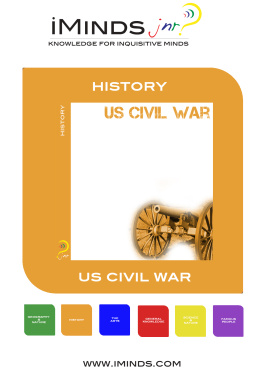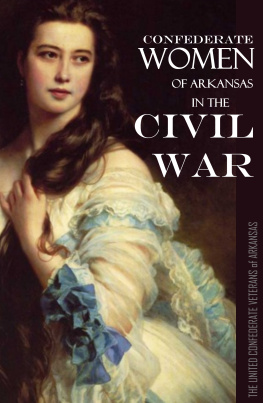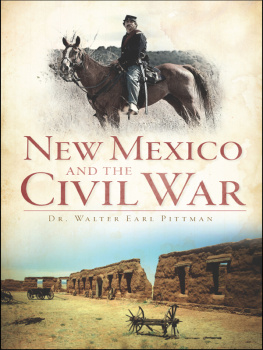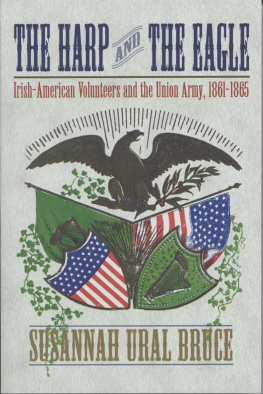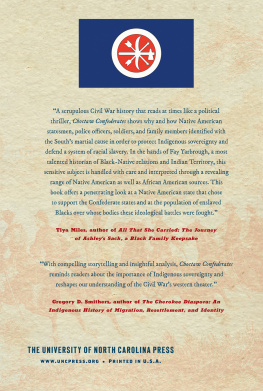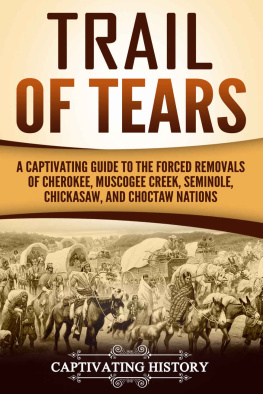Copyright 2019 by Clint Crowe
All rights reserved. No part of this publication may be reproduced, stored in a retrieval system, or transmitted, in any form or by any means, electronic, mechanical, photocopying, recording, or otherwise, without the prior written permission of the publisher.
Library of Congress Cataloging-in-Publication Data
Names: Crowe, Clint, author.
Title: Caught in the Maelstrom: The Indian Nations in the Civil War, 1861-1865 / by Clint Crowe.
Description: First edition. | El Dorado Hills, California: Savas Beatie, [2019] |
Includes bibliographical references and index.
Identifiers: LCCN 2019005197| ISBN 9781611213362 (hardcover: alk. paper) |
ISBN 9781940669687 (ebk)
Mobi ISBN 9781940669687
Subjects: LCSH: Indians of North AmericaHistoryCivil War, 1861-1865. |
United StatesHistoryCivil War, 1861-1865Participation, Indian.
Classification: LCC E540.I3 C76 2019 | DDC 973.70897--dc23
LC record available at https://lccn.loc.gov/2019005197
First edition, first printing
Savas Beatie
989 Governor Drive, Suite 102
El Dorado Hills, CA 95762
Phone: 916-941-6896
(web) www.savasbeatie.com
(E-mail)
Our titles are available at special discounts for bulk purchases. For more details,
contact us at .
Maps by Hal Jespersen
Introduction
The Choctaws, Chickasaws, Seminoles, Creeks, and Cherokees resisted removal from the southeast to west of the Mississippi in modern day eastern Oklahoma. When the mixed blood leadership signed removal treaties, the result, particularly in the Creek and Cherokee Nations, was violence and separation that continued for years after removal. The mixed blood, English-speaking, slaveholding factions and the full-blood, native-speaking communities lived apart within their new nations in the westernmost reaches of the South. When the Civil War approached, the five nations officially aligned with the Confederacy, the division over removal returned, and the full bloods aligned with the Union. The result was a civil war within the Civil War.
The division in the Cherokee Nation manifested itself in the growth of secret societies. The full bloods mobilized the Keetoowah Society, which maintained ties to traditional culture while maintaining a close relationship with abolitionist Baptist missionaries Evan and John Jones. The mixed blood English speakers were active in the Knights of the Golden Circle. This pro-slavery organization formed the nucleus of many early Confederate military units across the South. In the Indian Nations, its leaders maintained close relationships with secessionist politicians in the adjoining Southern states.
Arkansas and Texas leaders lobbied their slaveholding neighbors to join them in the secessionist movement. Understanding that his full-blood political base opposed the alliance with the Confederacy, Cherokee Chief John Ross resisted. Stand Watie led the Rebel Cherokees. Eventually Ross was forced to accept a Confederate alliance to keep the nation united and his power intact, while gambling that the full bloods would remain loyal to his leadership. Arkansas lawyer Albert
Creek and Cherokee full bloods resisted the Confederate alliances from the beginning. While full blood Cherokees bided their time within the Keetoowah Society, full blood Creeks openly opposed the alliance with the Confederacy. Chief Opothleyahola was the leader of the Creek opposition. He let the opposition believe that he was taking his people west to the Southern Plains. Instead, he used this deception to lead his people northeast into the Cherokee Nation. There members of the Keetoowah Society joined Opothleyahola, who had been promised military assistance by Union authorities in Kansas. In the process, Opothleyaholas forces won two engagements against their Confederate pursuers, but, when Federal support failed to materialize, Texas cavalry defeated and drove the refugees north into Kansas during a deadly snow storm. The young men among them became the nucleus of the Union Indian Brigade under the command of Col. William Phillips.
Two Cherokee regiments were at the battle of Pea Ridge in March of 1862, but their performance has been misinterpreted. The mixed blood Cherokee regiment enthusiastically supported the Confederacy. The full blood Keetoowah regiment was not motivated to fight for the Rebels, but when it was later allied with the Union, it served bravely. When federal forces reoccupied the Cherokee Nation, the remaining full bloods aligned with the Union, and to the end of the war both Creek and Cherokee full bloods made valuable contributions to Union victories.
In 1862 and 1863, Union and Confederate forces contended for control of the Indian Nations. The Union army occupied Fort Gibson and, following a series of battles that culminated in a Union victory at the battle of Honey Springs, took possession of Fort Smith. The result created refugees on both sides. Confederate-aligned families from the Cherokee and Creek Nations, numbering around 14,000, fled south to tributaries of the Red River, and Union-aligned families, numbering some 16,000, fled first to Kansas and then moved to Fort Gibson, where they remained to the end of the war. Both Union and Confederate authorities organized efforts to feed and shelter the refugees. Senator James H. Lane of Kansas, Union Gen. James G. Blunt, and their associates defrauded the federal government through kickbacks and fixed civilian contracts to supply troops and subsist the full blood Indian refugees.
Following the battle of Honey Springs, Confederate forces reorganized under a new commander, Gen. Samuel Bell Maxey, who reported directly to Lt. Gen. Edmund Kirby Smith, commander of the Trans-Mississippi Department. There were successful campaigns, coordinated with other Confederate forces in the department, including the defense against the Camden Expedition in Arkansas; a demonstration against Fort Smith; and, the disruption of traffic on the Arkansas River and overland supply trains to Fort Gibson. These campaigns were especially notable because Confederates refused to take prisoners from the 1st Kansas Colored Infantry and other black units in the theater.
High-level political activity on both sides attended these developments. President Abraham Lincoln needed Senator Lanes political support, despite the corruption of Lane and Blunt. There was also communication between Kirby Smith, Maxey, the Indian leadership, and the office of Confederate President Jefferson Davis and members of his cabinet about a dispute regarding the chain of command and the supply of ordnance. The story ended with the collapse of the Confederate military organization of the Trans-Mississippi and the onset of Reconstruction, also rife with division between the full bloods and mixed bloods. As a result, the Indian participants, Union as well as Confederate, shared in the loss of lands in the West, which they technically owned but were actually controlled by Comanches, Kiowas, and other Plains Indians, and which the Interior Department needed for the planned reservation system. Unfortunately, the land the Five Tribes had settled and retained lay in ruins.
Rosss biographer, Gary E. Bolton, in John Ross, Cherokee Chief (Athens, GA, 1978), 1-14, provides details of Rosss ancestry of Scottish traders, mixed and full blood wives, and their offspring, but he rightly does not attempt an exact ratio. One-sixteenth is commonly used. According to Moulton, he was not a fluent Cherokee speaker. The complexity of full blood and mixed blood relationships before Removal is reflected in Theda Perdue, Mixed Blood Indians: Racial Construction in the Early South (Athens, GA, passim) 85-103.


